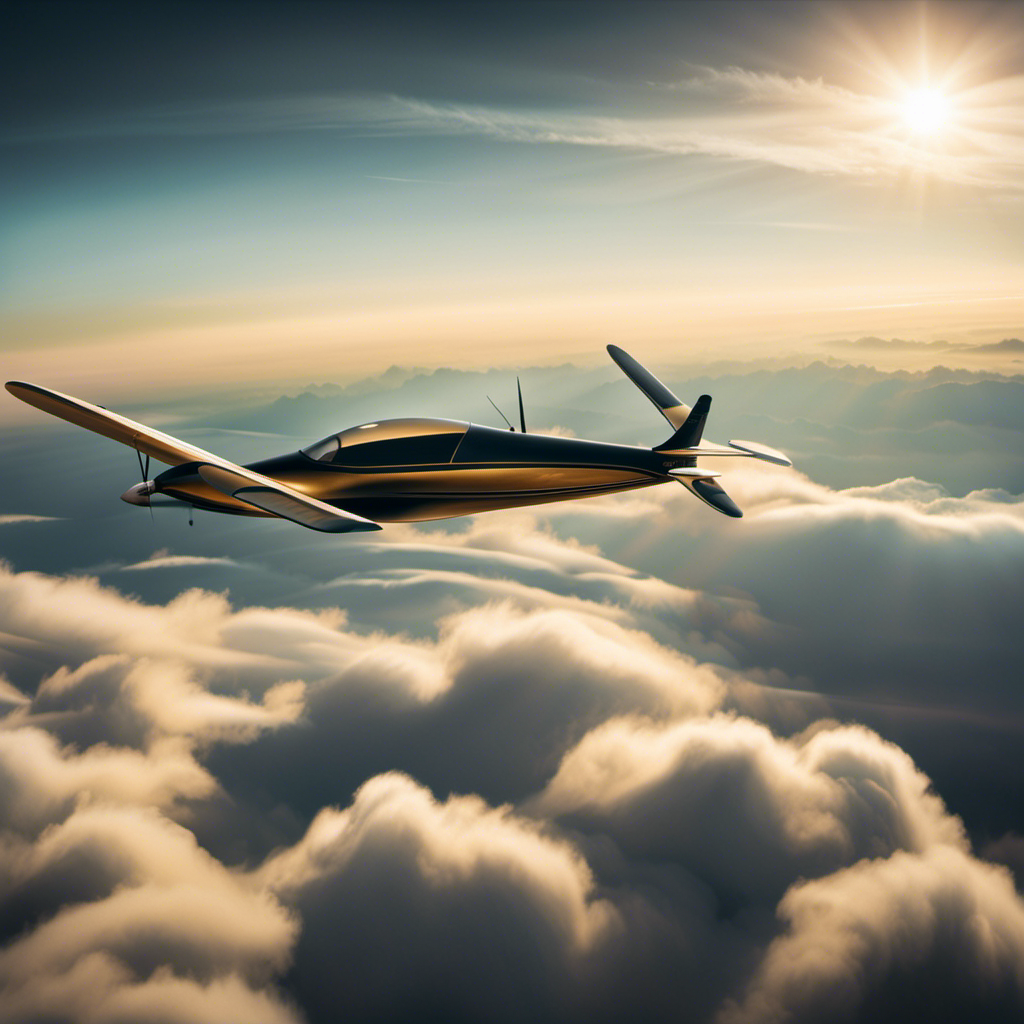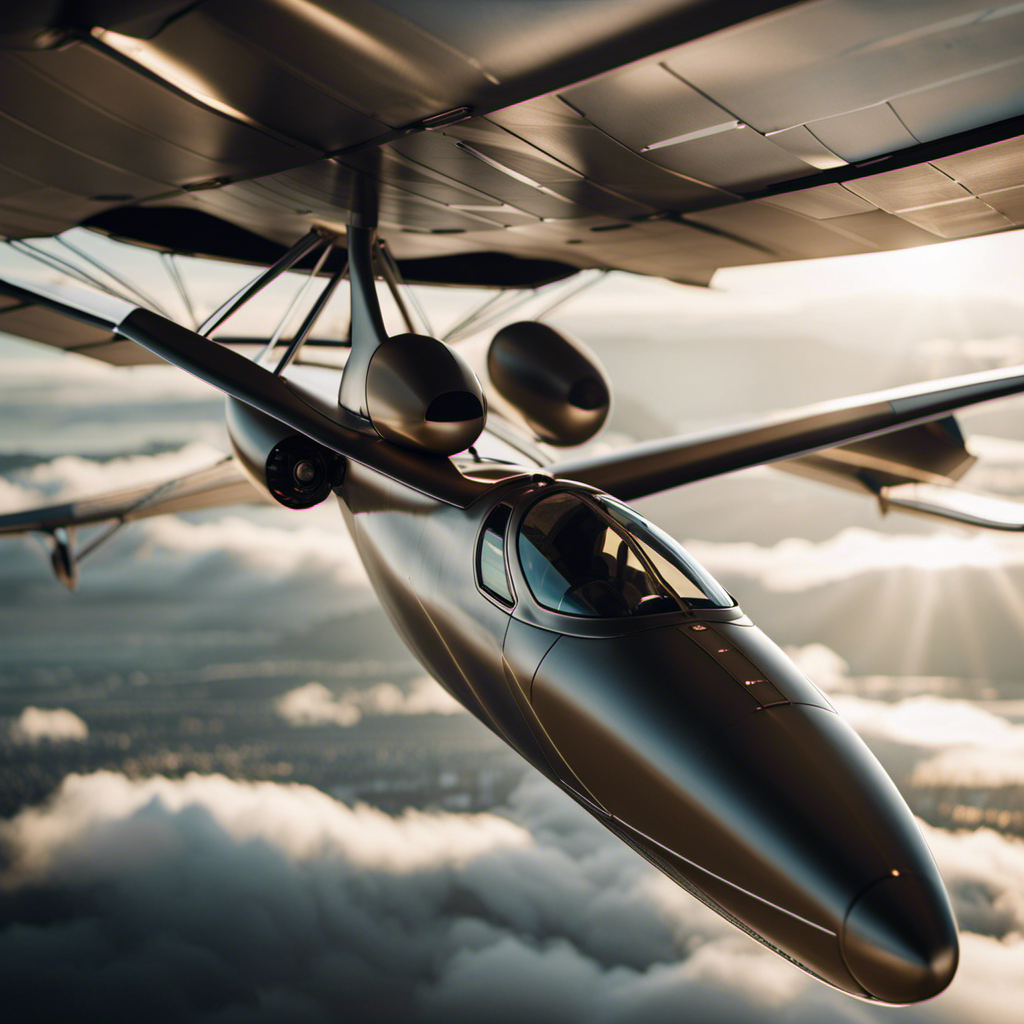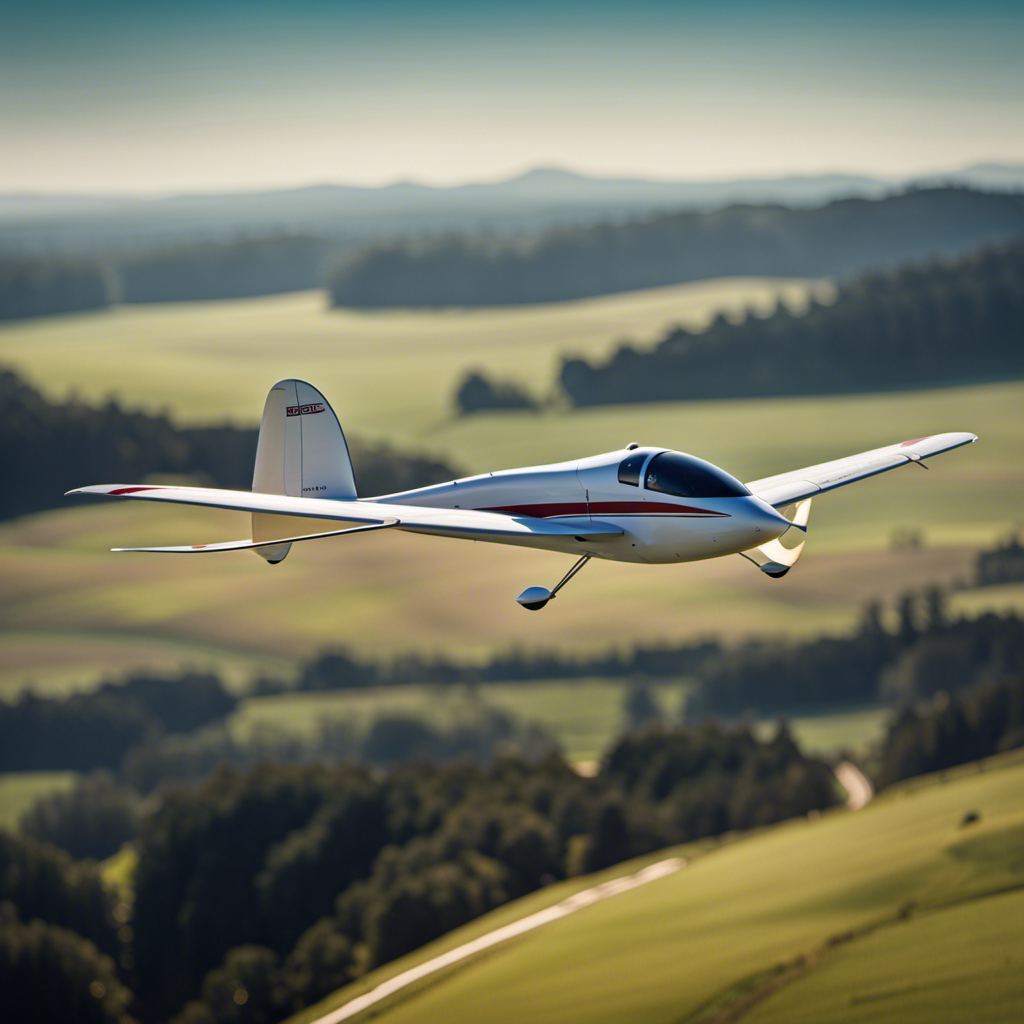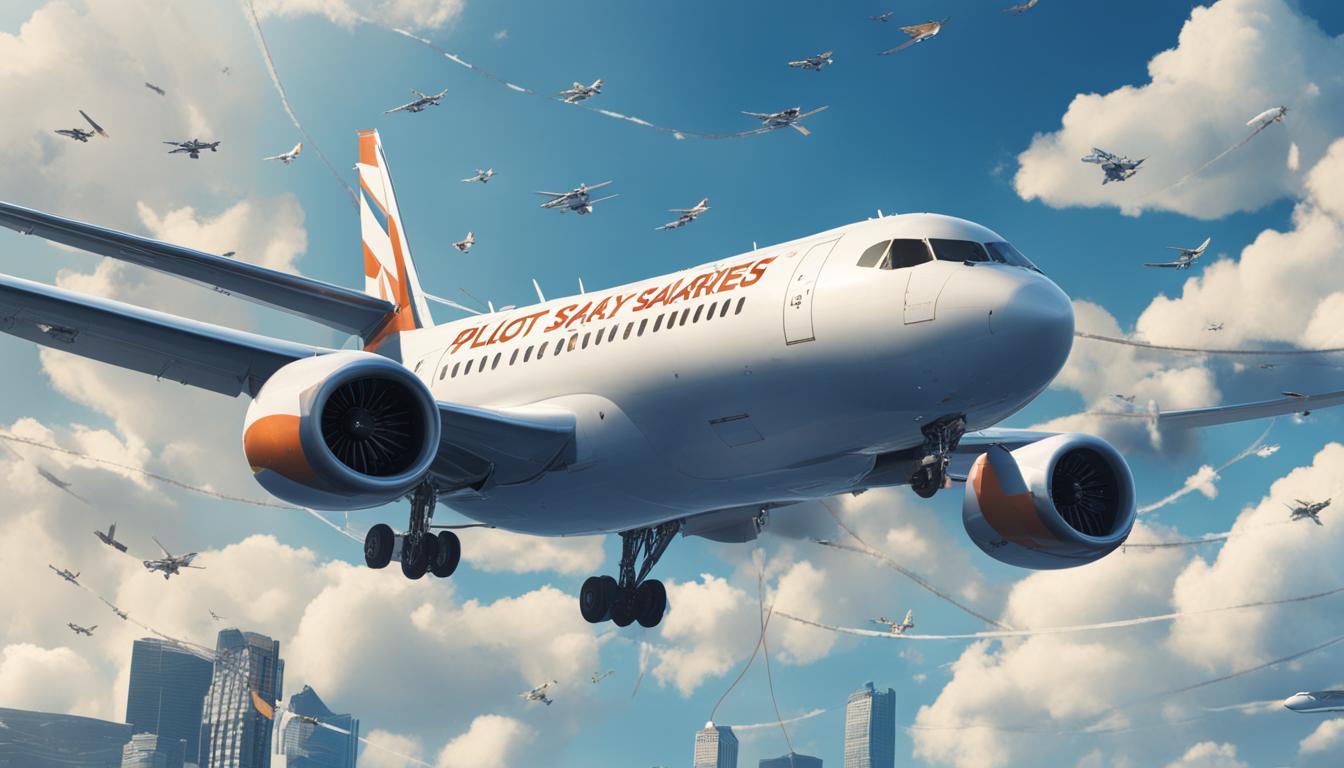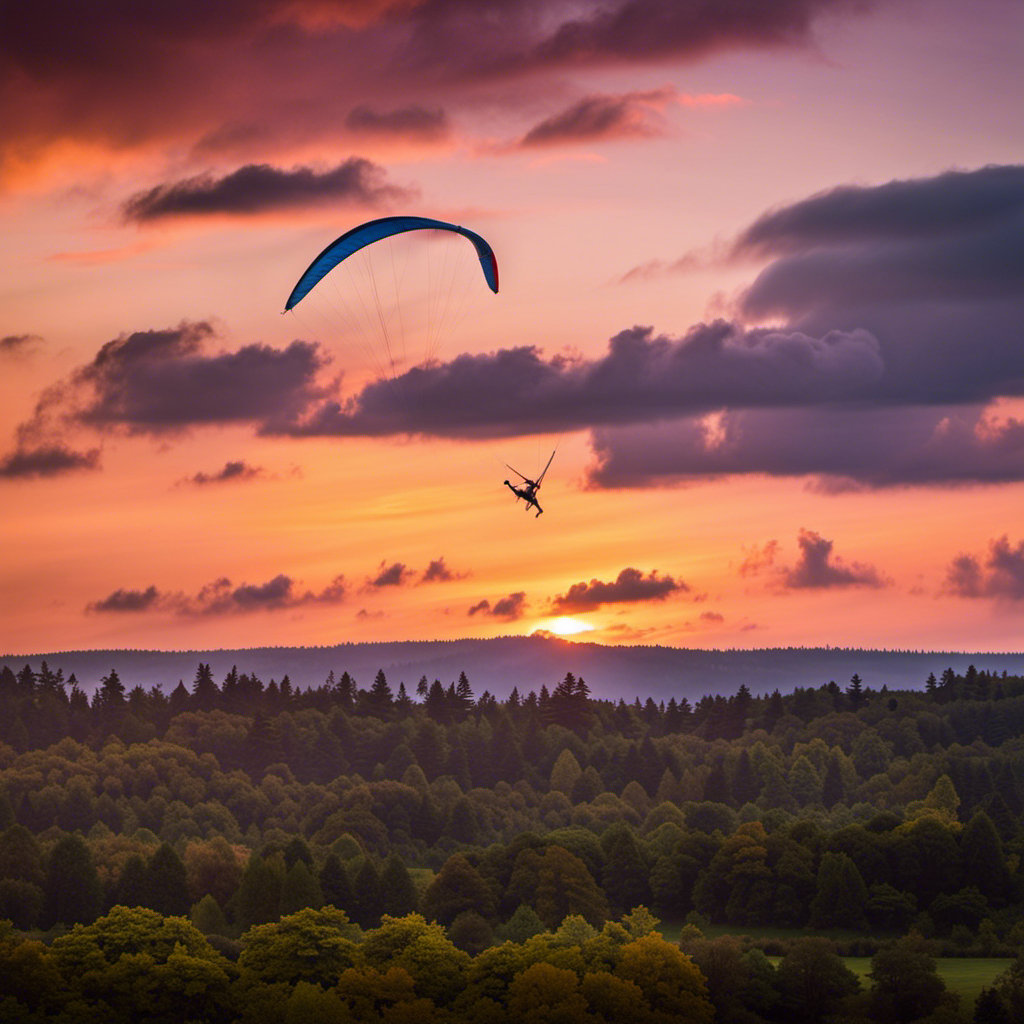Since I was young, I’ve always been fascinated by **flight**, the idea of gracefully soaring through the sky, relying only on the breeze beneath my wings. **Glider** planes have a special place in my heart because of this unmatched feeling of freedom they provide. If you share this love for **flying**, you’ll understand why I can’t get enough of glider aircraft. Let’s embark on this **adventure** together and discover the magic of gliding.
In this article, we’ll delve into the history of airplane gliders, explore how they work, discuss the different types available, and highlight the benefits of glider flying.
So fasten your seatbelts (or should I say unfasten them?), because we’re about to embark on an adventure that combines the thrill of flight with the serenity of soaring.
Key Takeaways
- Glider flight techniques and designs have evolved over centuries, with advancements made by notable individuals in aviation history such as Sir George Cayley, Otto Lilienthal, and the Wright brothers.
- Gliders work by utilizing air currents and aerodynamics, generating lift through the shape of their wings while experiencing drag as resistance.
- There are various types of airplane gliders, including sailplanes, aerobatic gliders, motor gliders, vintage gliders, and ultralight gliders, each designed for different purposes and capabilities.
- Glider flying offers benefits such as environmental sustainability, cost-effectiveness, enhanced sensory experiences, reduced carbon emissions, and the preservation of natural resources. Additionally, joining glider clubs provides access to a supportive community, training opportunities, well-maintained gliders for rental, and the chance to improve flying skills and connect with fellow aviation enthusiasts.
The History of Airplane Gliders
You might be interested to know that the history of airplane gliders dates back to ancient times. The concept of gliding through the air without the use of an engine has fascinated humans for centuries. The history of glider design can be traced back to the 9th century in China, where kites were used as a form of entertainment and experimentation. Over the years, glider flight techniques and designs evolved, with notable contributions from individuals such as Sir George Cayley, Otto Lilienthal, and the Wright brothers.
Sir George Cayley, often referred to as the father of aviation, made significant advancements in glider design during the early 19th century. He recognized the importance of aerodynamics and stability in flight and developed the modern concept of a fixed-wing aircraft. His experiments and theories laid the foundation for future glider designs.
Otto Lilienthal, a German aviation pioneer, furthered the development of gliders in the late 19th century. He conducted extensive research on airfoils and wing shapes, which greatly improved the lift and control of glider flights. Lilienthal’s work inspired and influenced the Wright brothers in their pursuit of powered flight.
The Wright brothers, Orville and Wilbur, are credited with achieving the first successful manned, powered flight in 1903. Their early experiments with gliders allowed them to understand the principles of flight and refine their aircraft designs. They incorporated various glider flight techniques, such as the use of wing-warping for control, into their powered aircraft.
In conclusion, the history of airplane gliders spans centuries and has seen remarkable advancements in design and flight techniques. From the early experiments in China to the breakthroughs by Cayley, Lilienthal, and the Wright brothers, glider design has paved the way for modern aviation.
Now that we understand the historical context, let’s delve into how airplane gliders work.
How Airplane Gliders Work
The way airplane gliders function is through the use of air currents and their ability to glide through the sky. Glider technology is based on the principles of aerodynamics, which involves the study of how objects move through the air. Gliders are designed to take advantage of the forces acting on them during flight, such as lift and drag.
Lift is generated by the shape of the glider’s wings, which are curved on top and flat on the bottom. As the glider moves through the air, the shape of the wings causes the air above them to move faster, creating a lower pressure area. This pressure difference generates lift, allowing the glider to stay airborne.
Drag, on the other hand, is the resistance that the glider experiences as it moves through the air. Glider designers aim to minimize drag by streamlining the shape of the aircraft and reducing any unnecessary protrusions.
By combining the forces of lift and drag, gliders are able to stay aloft and glide through the air. This unique ability allows pilots to navigate through the sky without the need for an engine.
Now that we understand how gliders work, let’s explore the different types of airplane gliders.
Types of Airplane Gliders
Now that we’ve covered how gliders work, let’s take a look at the different types available. Glider manufacturing involves careful engineering and design to ensure maximum efficiency and safety. There are various types of gliders, each with its unique characteristics and purpose.
| Glider Type | Description |
|---|---|
| Sailplane | The most common type of glider, designed for soaring and long-distance flights. It has a sleek, streamlined body and large wings to generate lift. |
| Aerobatic Glider | These gliders are built to withstand high G-forces and perform aerobatic maneuvers. They have reinforced structures, strong control surfaces, and specialized safety features. |
| Motor Glider | Combining the benefits of both gliders and powered aircraft, motor gliders have an engine that can be retracted during soaring flights. This feature allows pilots to take off and climb to higher altitudes before gliding. |
| Vintage Glider | These gliders are replicas of early 20th-century designs. They offer a nostalgic experience and are often used for recreational flights and airshows. |
| Ultralight Glider | Lightweight and compact, ultralight gliders are easy to transport and assemble. They are ideal for beginners and pilots who enjoy recreational flying. |
Understanding glider aerodynamics is crucial for manufacturers to optimize performance. By reducing drag and maximizing lift, gliders can achieve longer flight times and cover greater distances. Design features such as wing shape, aspect ratio, and airfoil profile contribute to the aerodynamic efficiency of gliders.
With an overview of the different types of gliders and their aerodynamics, we can now explore the benefits of glider flying.
The Benefits of Glider Flying
When it comes to glider flying, there are several key benefits to consider.
First and foremost, gliders are environmentally sustainable, as they don’t rely on fossil fuels to stay in the air. This not only reduces carbon emissions, but also helps to preserve our natural resources.
Additionally, glider flying is cost-effective, as it eliminates the need for fuel and engine maintenance, making it a more affordable option for aviation enthusiasts.
Lastly, glider flying offers an enhanced sensory experience, allowing pilots to fully immerse themselves in the sights, sounds, and sensations of flying without the noise and distractions of an engine.
Environmental Sustainability
You can reduce your carbon footprint by flying in environmentally sustainable airplane gliders. These gliders are designed to operate using renewable energy sources, such as solar power. By harnessing the energy from the sun, they are able to stay aloft for extended periods without producing any harmful emissions. This makes them an excellent choice for eco-conscious individuals who want to enjoy the thrill of flight while minimizing their impact on the environment.
In addition to reducing carbon emissions, flying in gliders also helps to preserve natural resources by relying on renewable energy. This combination of renewable energy and reduced carbon emissions makes airplane gliders a sustainable choice for aviation enthusiasts.
Transitioning into the next section, let’s explore the cost-effectiveness of flying in gliders.
Cost-Effectiveness
Flying in environmentally sustainable airplane gliders can be a cost-effective way to enjoy the serenity of soaring through the sky. These gliders offer various cost saving measures, making them an economically viable option for aviation enthusiasts. Here are some reasons why airplane gliders are a cost-effective choice:
-
Minimal fuel consumption:
-
Gliders rely on wind currents and thermal energy for propulsion, eliminating the need for fuel and reducing operational costs.
-
This makes glider flights significantly cheaper compared to traditional powered aircraft.
-
Lower maintenance expenses:
-
Airplane gliders have simpler designs with fewer moving parts, resulting in reduced maintenance requirements and costs.
-
Fewer components also mean reduced chances of mechanical failures and the associated repair expenses.
With these cost saving measures, airplane gliders provide an affordable option for individuals seeking the thrill of flight. Furthermore, these economic advantages can be combined with the enhanced sensory experience of soaring through the sky, which will be discussed in the following section.
Enhanced Sensory Experience
Experiencing the wind rush against your face and the breathtaking views from high above create a truly immersive and sensory-rich adventure. Gliding through the air in an airplane glider, you are able to feel the elements in a way that is unparalleled.
The lack of an engine allows for enhanced sensory immersion, as you are able to hear the whistling of the wind and feel the subtle changes in air pressure. The glider’s large windows provide panoramic views of the surrounding landscape, allowing you to appreciate the beauty of nature from a unique perspective.
This heightened sensory experience can also promote mindfulness in flight, as you become fully present in the moment, attuned to the sensations and surroundings.
Transitioning into the subsequent section about training and certification for glider pilots, it is important to understand the necessary skills and knowledge required to safely navigate the skies.
Training and Certification for Glider Pilots
Obtaining certification for glider pilots involves completing a rigorous training program. As a glider pilot, I can attest to the demanding yet rewarding process of becoming certified.
The certification process for glider pilots consists of several key components:
-
Ground School: Glider pilot training begins with comprehensive ground school instruction. This includes learning about aerodynamics, meteorology, navigation, and flight rules and regulations. It provides a solid foundation of knowledge essential for safe glider operations.
-
Flight Training: The next step is hands-on flight training. Under the guidance of experienced flight instructors, aspiring glider pilots learn the intricacies of glider handling, takeoff, landing, and emergency procedures. This practical training hones their skills and builds confidence in their ability to fly gliders safely.
-
Solo Flights and Checkrides: Once the flight training is completed, the aspiring glider pilot must demonstrate their proficiency through solo flights and checkrides. These evaluations assess their ability to apply what they’ve learned and make sound decisions in various flight scenarios.
Transitioning into the subsequent section about glider competitions and events, the certification process for glider pilots prepares us not only for recreational flying but also for the thrilling world of glider competitions and events.
Glider Competitions and Events
After completing the necessary training and obtaining the required certification, glider pilots are often drawn to the excitement and camaraderie of glider competitions and events. These gatherings provide an opportunity for pilots to showcase their skills, challenge themselves, and learn from fellow enthusiasts.
One popular aspect of glider competitions is glider aerobatics, which involves performing a series of thrilling maneuvers such as loops, rolls, and spins. These dazzling displays of skill and precision captivate both participants and spectators alike. Glider aerobatics require a deep understanding of the aircraft’s capabilities and careful coordination between the pilot and the glider.
Another integral part of glider competitions is glider towing. This involves using a powered aircraft to tow the glider into the air, allowing it to gain altitude before releasing it to soar freely. This method of launch is widely used in competitions to ensure a fair and equal start for all participants. Towing requires precise communication and coordination between the tow pilot and the glider pilot, as they must work together to achieve a successful launch.
Overall, glider competitions and events provide a platform for pilots to demonstrate their skills, push the boundaries of their abilities, and connect with other aviation enthusiasts. These gatherings foster a sense of community and inspire pilots to continually improve their flying techniques.
Transitioning into the subsequent section about safety considerations in glider flying, it is crucial for pilots to prioritize safety while participating in these thrilling events.
Safety Considerations in Glider Flying
While participating in glider competitions and events, pilots must prioritize safety to ensure a successful and enjoyable experience. Glider flying can be thrilling and serene at the same time, but it also comes with its fair share of risks. As a pilot, I understand the importance of adhering to safety considerations and following emergency procedures to mitigate any potential dangers.
Here are some key safety considerations that every glider pilot should keep in mind:
-
Weather conditions:
Checking the weather forecast before every flight is crucial. Unfavorable weather conditions such as strong winds, thunderstorms, or low visibility can pose significant risks. Being aware of local weather patterns and understanding how they can affect glider operations is essential for safe flying. -
Emergency procedures:
Familiarizing oneself with emergency procedures is vital in case of unexpected situations. This includes knowing how to handle an unplanned landing or a sudden loss of altitude. Regular training and practice of emergency maneuvers can help pilots react quickly and effectively during critical moments.
By prioritizing safety and being prepared for any potential emergencies, glider pilots can enjoy the beauty of soaring through the skies with peace of mind.
Now let’s delve into the world of glider clubs and organizations, where pilots can connect and share their passion for gliding.
Glider Clubs and Organizations
Joining a glider club offers numerous benefits to aviation enthusiasts like myself.
First and foremost, being part of a glider club provides access to a supportive community of fellow pilots who share the same passion for soaring.
Additionally, membership in a glider club often includes access to training and mentorship opportunities, helping to improve one’s flying skills and knowledge.
Lastly, glider clubs often have well-maintained gliders available for rental, allowing members to enjoy the exhilarating experience of gliding without the need for owning their own aircraft.
Joining a Glider Club
If you’re interested in joining a glider club, you’ll have the opportunity to learn from experienced pilots. Being a part of a glider club offers a range of activities that can bring excitement and fulfillment to your flying experience. Here are three things that you can expect when you join a glider club:
-
Soaring through the sky: Glider clubs organize regular flying sessions where you can take to the air and experience the thrill of soaring without an engine. It’s a unique feeling of freedom and tranquility as you glide through the air, powered only by the forces of nature.
-
Learning from experts: Glider clubs provide access to experienced pilots who are eager to share their knowledge and expertise. They can guide you through the intricacies of glider flying, teaching you the skills needed to become a proficient pilot.
-
Building a community: Joining a glider club allows you to connect with like-minded individuals who share your passion for aviation. You’ll have the chance to build lasting friendships and be a part of a supportive community that fosters camaraderie and collaboration.
Benefits of Membership
As a member of a glider club, you’ll enjoy the benefits of connecting with a supportive community of fellow aviation enthusiasts. Being part of the glider community means being surrounded by individuals who share your passion for flight and the beauty of soaring through the air. The camaraderie and sense of belonging that comes with being a member is invaluable.
Additionally, membership perks often include access to top-notch glider facilities, discounts on equipment and training, and opportunities to participate in events and competitions. Whether you are a seasoned glider pilot or just starting out, being part of a glider club provides a supportive network of like-minded individuals who are always ready to share knowledge and experiences.
Famous Glider Pilots and Records
When it comes to glider aviation, there have been many notable pilots throughout history who have made significant contributions to the sport.
From Otto Lilienthal, the ‘father of gliding,’ to Steve Fossett, who set multiple world records in glider flights, these individuals have pushed the boundaries of what is possible in the world of soaring.
Their records and achievements serve as inspiration to aspiring glider pilots and demonstrate the incredible capabilities of these aircraft.
Notable Glider Pilots in History
There’s no doubt that one of the most notable glider pilots in history is Amelia Earhart. Her adventurous spirit and determination have inspired countless individuals to take up glider flying. But she is not the only one who has left a significant mark in the world of glider aviation.
Other notable glider pilots include Otto Lilienthal, who is considered the father of modern gliding, and Steve Fossett, who set numerous records in glider flying.
Glider flying has a profound impact on mental well-being. The sense of freedom and tranquility experienced while soaring through the sky can be incredibly therapeutic and uplifting. It allows pilots to escape the stresses of everyday life and find solace in the beauty of nature.
Now let’s delve into the remarkable records and achievements in glider aviation.
Records and Achievements in Glider Aviation
Glider pilots have achieved remarkable records throughout the history of aviation. Glider world records and aviation achievements demonstrate the incredible capabilities of these aircraft and the skill of the pilots who fly them.
The longest glider flight ever recorded was accomplished by Klaus Ohlmann, who soared for an astonishing 1,836 kilometers in Argentina. Another notable achievement is the highest altitude reached by a glider, which stands at 15,460 meters and was accomplished by Steve Fossett.
These records highlight the endurance and versatility of gliders, as well as the determination of pilots to push the boundaries of aviation. With such incredible accomplishments in mind, it is no wonder that planning your own glider adventure can be an exhilarating prospect.
Planning Your Glider Adventure
When it comes to planning a glider adventure, two key points to consider are the glider flying locations and destinations as well as how to book a glider flight experience.
Finding the right location is crucial, as it determines the scenery, weather conditions, and overall experience.
Once you’ve chosen a destination, booking a glider flight experience can be done through various methods, such as contacting local glider clubs or booking directly with glider flight operators.
Glider Flying Locations and Destinations
You can explore various breathtaking locations and destinations for glider flying. The equipment used for glider flying is specifically designed for a safe and enjoyable experience.
Gliders are lightweight aircraft that rely on wind currents to stay aloft, and they are equipped with a cockpit, controls, and safety features. To master glider flying techniques, you need to learn how to control the glider using the flight controls and understand how to read the weather conditions.
It is important to be proficient in understanding wind patterns and thermals, as they play a crucial role in glider flying. Once you have mastered the necessary skills, you can choose from a wide range of stunning locations and destinations to experience the thrill of glider flying.
From soaring above picturesque mountains to gliding over sparkling coastal landscapes, each location offers its own unique charm and beauty. As you plan your glider flight experience, you can choose a destination that suits your preferences and allows you to explore the world from a whole new perspective.
Booking a Glider Flight Experience
Booking a glider flight experience can be an exciting opportunity to explore the world from a different perspective. Whether you’re a thrill-seeker or simply want to enjoy the serenity of soaring through the sky, glider flights offer a unique and unforgettable adventure.
Here are a few things to consider when booking your glider flight:
-
Glider flight availability: Check with local glider flight operators to see if they offer flights in your desired location. Some areas may have limited availability based on weather conditions and other factors.
-
Glider flight packages: Look for packages that suit your preferences and budget. Some operators offer introductory flights for beginners, while others provide longer flights for those seeking a more immersive experience.
-
Pricing: Compare prices from different operators to find the best deal. Keep in mind that prices may vary depending on the duration of the flight and any additional services included.
-
Safety precautions: Prioritize operators that prioritize safety and have experienced pilots. Ask about their safety record and any certifications they hold.
Frequently Asked Questions
Are airplane gliders powered by engines or do they rely solely on wind currents for flight?
Airplane gliders rely solely on wind currents for flight, as they are engineless. They utilize the principles of aerodynamics to maintain lift and stay airborne. The absence of an engine adds to the peaceful and serene experience of gliding through the air.
How long can airplane gliders stay airborne without any additional power?
Airplane gliders can stay airborne for hours without any additional power, much to the delight of glider enthusiasts. This is crucial in glider competitions, where endurance is key. However, regular maintenance is necessary to ensure their continued performance.
Can airplane gliders be used for long-distance travel or are they primarily used for recreational purposes?
Airplane gliders can be used for long-distance travel due to their long flight endurance. Safety measures, such as regular inspections and training, ensure a safe journey.
Are there any age restrictions for operating an airplane glider?
There are no age restrictions for operating an airplane glider, but safety regulations for glider flying require individuals to be physically fit and mentally capable of handling the responsibilities of piloting a glider.
Are there any specific weather conditions that are unsafe for glider flying?
Certain weather conditions can be unsafe for glider flying. Safety precautions include avoiding strong winds, thunderstorms, and low visibility. It’s important to check weather forecasts and consult with experienced pilots before taking off.
Conclusion
In conclusion, airplane gliders offer a unique and exhilarating experience that combines the thrill of flight with the serenity of soaring through the sky.
Despite the lack of an engine, these aircraft rely on the power of nature to stay aloft, making each flight a truly remarkable and eco-friendly experience.
While some may argue that glider flying is too risky, it is important to note that extensive training and certification are required for glider pilots, ensuring their safety and competence in the air.
So don’t let the absence of an engine deter you, embark on a glider adventure and discover the beauty of silent flight.
With a heart that soars as high as the skies, Aria, affectionately known as “Skylark,” is the driving force behind Soaring Skyways. Her journey into the gliding world began as a young dreamer gazing up at the soaring birds, yearning to experience the weightlessness and freedom they embodied. With years of experience both in the cockpit and behind the scenes, Aria’s commitment to the gliding community is unwavering.
